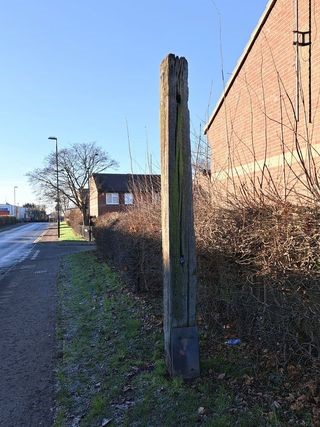
My name is Peter Hunter. I’m a Coventry Society member with an interest in all things Coventry and a passion for running. I try to combine these two activities by taking – in places of interest whilst out jogging. I wrote a few pieces entitled “the Old Guy goes jogging” in 2023, but time for writing became scarce in recent months, however I’m looking to resume my writing in 2024 combining my love of running and my fascination with my city.
The last piece that I wrote in 2023 focused on an original cast iron canal bridge rubbing post on the Coventry Canal at bridge 6, Bell Green – a post used to prevent the ropes on horse drawn barges from damaging bridge brickwork. This time, it’s another post – bigger, wooden and maybe its past use isn’t quite as obvious.
Deedmore Rd. in the far north – east of the city has a long history, not much of which is apparent if you drive, walk (or run) along there nowadays. However, the area around what is now the eastern entrance to Aldermans Green Industrial estate was a hive of mining activity through the nineteenth century (and before), with the mining activity only ceasing in 1927 with the closure of Craven Colliery on Henley Rd. nearby.
On the west side of Deedmore Rd., a hundred or so yards south of the entrance to Aldermans Green Industrial Estate stands a substantial wooden post, some 10 feet in height. It’s easy to miss it or to dismiss it without a thought, so what’s with the post? The answer is that it was a railway level – crossing gate post. A very tangible and now rare link with the area’s mining past.
The level crossing took the mineral branch line from Hawkesbury junction on the LNWR Coventry – Nuneaton Line to the site of the Alexandra Colliery which was on the east side of Deedmore Rd. close to the post’s location. When the level crossing was in operation, Deedmore Rd. was more appropriately named Colliery Lane.
The mineral line, which when fully operational was the best part of two miles in length, was originally constructed in 1862 to serve the Wyken Main Colliery which was at the top of the hill behind Wyken Slough, next to what is now the Coventry Canal Society’s Wyken Basin (the Basin was constructed to serve the colliery). This colliery closed in 1881 and coal extraction moved south – east, following the same coal seam to the Alexandra Colliery which lay south – east of Deedmore Rd. Alexandra colliery opened as Wyken Main closed. The railway was extended to the Alexandra Colliery site and sidings were built there. This colliery operated until 1919 at which time it in its turn was worked out.
Finally, coal extraction of the same seam moved further south – east again to the Craven Colliery off Henley Rd. The rail line was never extended as far as Craven Colliery which was the last of these 3 linked mines. Craven Colliery was however served by an “endless rope” tramway system taking coal from Henley Rd. back to the screens and sidings at Alexandra Colliery where coal could be loaded to rail wagons or canal boats. There was a canal basin serving Alexandra Colliery as well as rail sidings.
The rail line to the mines closed around 1927 when Craven Colliery finally closed. The level crossing would have fallen into disuse at this time. At the same time, Coventry Power Station was opening on Aldermans Green Rd. and a siding into the power station was taken from the same branch line. The rail line taking coal to the power station remained in use until 1967/8. The site of the power is what is now the hill behind the Greyhound public house.
I recollect that in the days of my youth in the 1960’s there was a level crossing gate similar to the Deedmore Rd. one on Aldermans Green Rd. close to the entrance to Coventry Power Station. However, that feature was lost when the M6 was built across the line of the track.
There are a couple of places where you can still see evidence of the mineral line in addition to the crossing post. The track-bed has been converted into a footpath in Hawkesbury Village between Blackhorse Rd and Ironbridge Way. Also, if you look closely in the Wyken Slough area, you can just make out the low rail embankment running alongside the motorway, although it is now much overgrown.
The crossing gate post on Deedmore Rd. isn’t quite in its original location. As Deedmore Rd. was widened and Aldermans Green Industrial Estate was created, the post was relocated a short distance to where it currently stands, but it is good that it has been retained to provide a tangible link with the area’s mining past.
So there we have it. The history of this area was very much shaped by extensive mining which would have been the principal source of male employment locally for well over a hundred years. And now so few tangible links with the past, other than a simple roadside post – with quite a story to tell.
